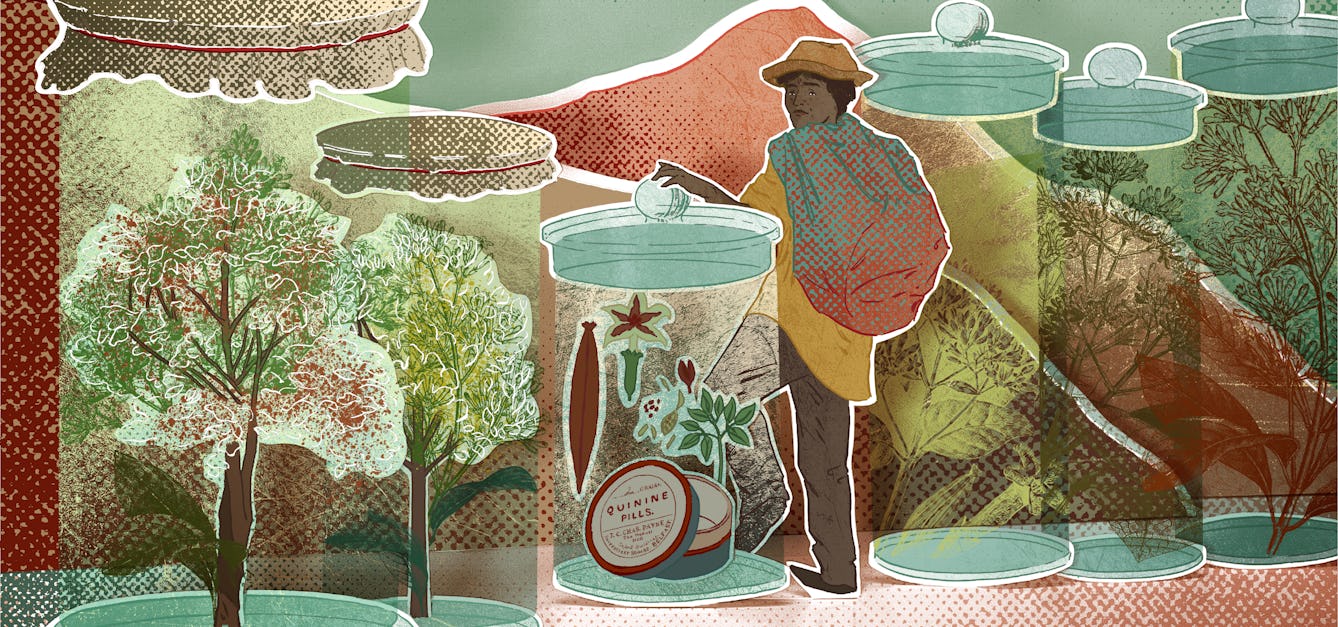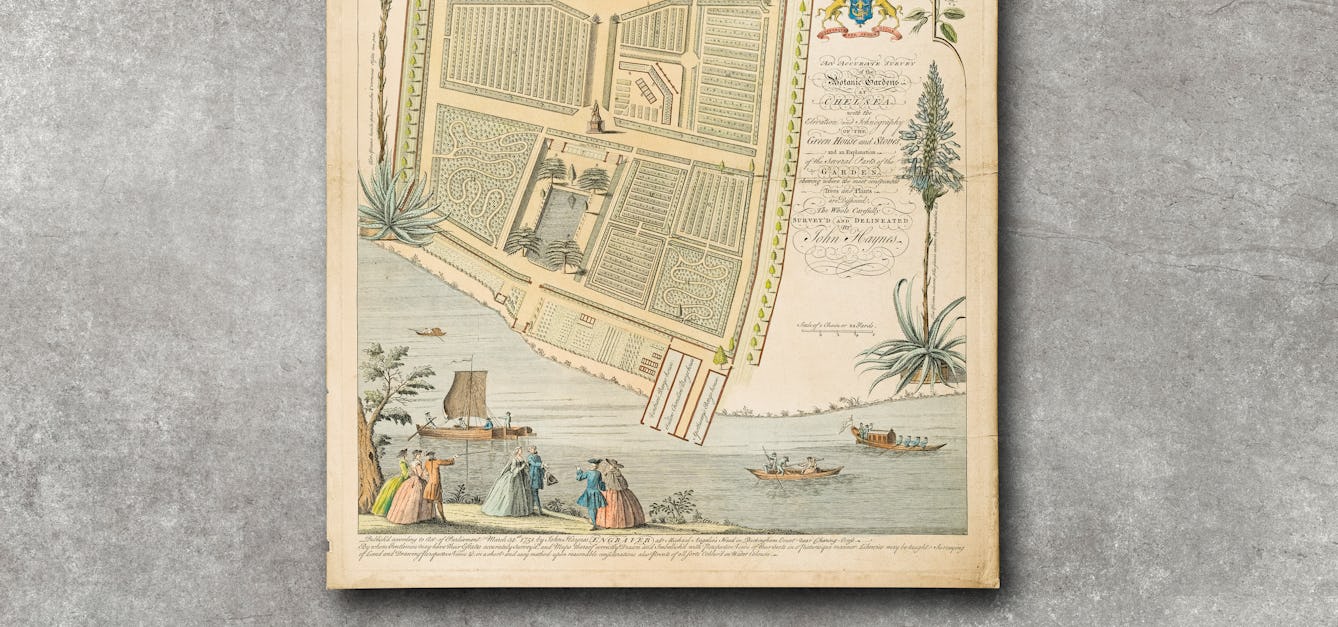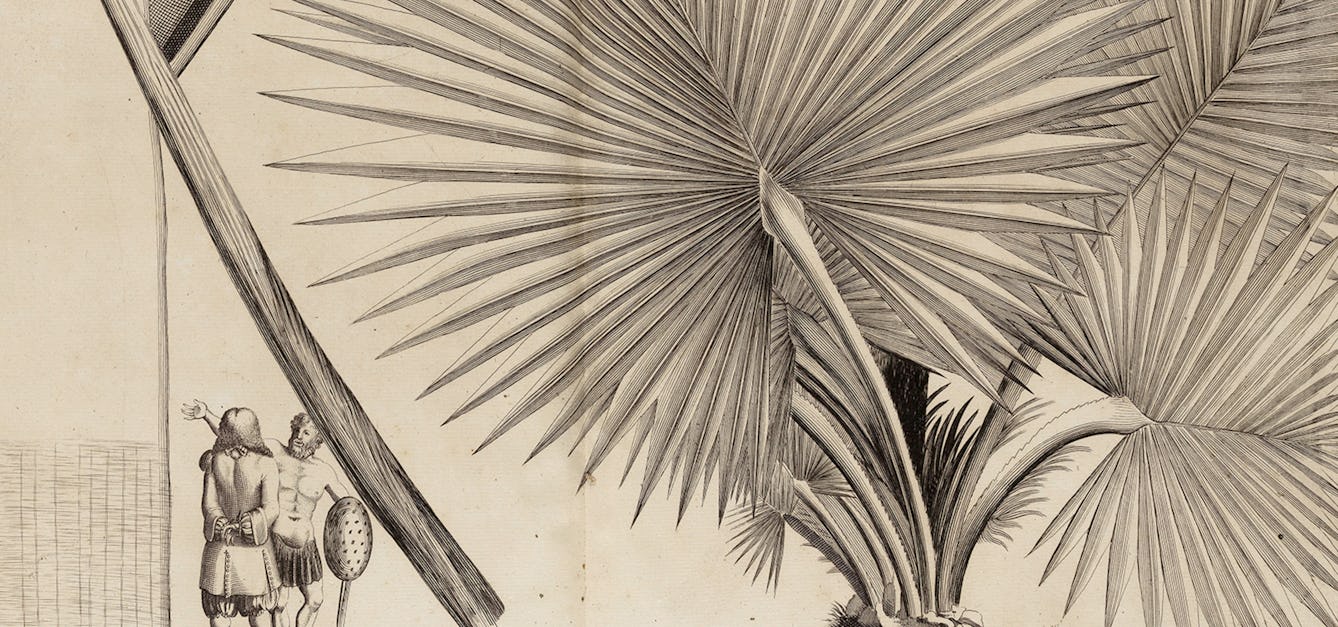Stories

- Article
Sacred cows and nutritional purity in India
Apoorva Sripathi explores the complex reasons behind India’s recent boom in all things dairy – beginning with a 1970s Western food-aid programme.

- Article
Hunting lost plants in botanical collections
A bark specimen at Kew recalls the story of a South American man who harvested the most potent source of the only effective malaria treatment available in the late 1800s. Killed for his work and forgotten by history, Manuel Mamani was a victim of the colonial juggernaut.

- Article
The healing power of the physic garden
Having experienced the healing power of plants and gardens, Iona Glen goes in search of present-day “physic gardens” and their origins in history.

- Article
Indian botanicals and heritage wars
Colonial botanical texts, as astonishingly beautiful as they are, may cast very dark shadows.
Catalogue
- Pictures
China rose or Shoe flower (Hibiscus rosa-sinensis L.): two flowering stems and separate fruits, flower and seeds - both whole and sectioned. Coloured line engraving by G. Appelman after M. Splinter.
Splinter, Marcelis, 1634-Date: [1686]Reference: 16212i- Books
The Indian pharmaceutical codex. Vol. I - Indigenous drugs / by B. Mukerji.
Mukerji, B. (Bishnu), 1903-Date: 1953
- Pictures
- Online
Garden rocket (Eruca vesicaria (L.) Cav. subsp. sativa (Miller) Thell.): flowering and fruiting stem with separate fruit and seeds. Coloured etching by M. Bouchard, 177-.
Reference: 17192i- Archives and manuscripts
Burroughs Wellcome & Co, Private Letter Book 1
Date: December 1881 - May 1897Reference: WF/E/03/01 (copy, part 1)Part of: Wellcome Foundation Ltd- Archives and manuscripts
Burroughs Wellcome & Co, Private Letter Book 1
Date: December 1881 - May 1897Reference: WF/E/03/01 (copy, part 2)Part of: Wellcome Foundation Ltd






![Pulmonaria officinalis L. Boraginaceae Distribution: Officinalis indicates its medicinal use in early medicine. Europe. Pulmonaria or Lungwort are names for a lichen and a perennial plant in the Boraginaceae. This is the latter. Lyte (1578) has a woodcut of our plant and also calls it Sage of Jerusalem and says it is of ' no particular use in physicke, but is much used in meates and salads with eggs, as is also Cowslippes and Primroses, whereunto in temperature it is much alike.' He lists and describes the lichen separately. Culpeper (1650) said he found many sorts of lunguewort in perusing Authors ' Pulmonari, arborea and Symphytum maculosum [and the latter is our plant, the others the lichen] and that they 'helpe infirmities of the lungues, as hoarseness, coughs, wheezing, shortnesse of breath etc.' Coles (1657) who espouses the Doctrine of Signatures in a way unrivalled by any other English author, might have been expected to confirm the concept that the mottled leaves looked like the cut surface of a lung which indicates their purpose, but he only mentions the lungwort which is a lichen. However, Porta's beautiful book on the Doctrine, Phytognomica (1588), is clear that the plant called Pulmonaria with hairy leaves like a bugloss, spotted white with purple flowers, commonly called 'cynoglossa' [with a woodcut which could be Pulmonaria officinalis] indicate its use for ulcerated lungs, spitting blood, shortness of breath and asthma equally with the lichen with the same name. Lobel & Pena (1570) call it 'PULMONARIA, masculosa folia Borrago, floribus Primula veris, purpureis [PULMONARIA spotted, Borage-leaved, flowers like Primula veris - Cowslips - purple]' and say that women mix the leaves with a little broth and make it into an omelette for lung disorders and to strengthen the heart. Lobel (1576) calls it Maculosa Pulmonaria and describes a white flowered form with a good woodcut. Gerard (1633) uses the same woodcut as Lobel and calls it Pulmonatia foliis Echii, Buglosse Cowslips with red flowers, and a woodcut of a narrow leaved plant as Pulmonaria masculosa, Spotted Cowslips of Jerusalem with red, blue and purple flowers and says 'the leaves are used among pot-herbes. The roots are aso thought to be good against the infirmities of ulcers of the lungs...'. Quincy (1718) writes: '... it has a glutinous juice ... and heals ulcers and erosions. It is commended in coughs and spitting of blood but is little used either in the Shop or Prescriptions. Not used in modern medicine. It is in the family Boraginaceae whose species are often rich in pyrrolizidine alkaloids that cause liver toxicity and liver cancers, but levels in Pulmonaria officinalis may not be significant. Photographed in the Medicinal Garden of the Royal College of Physicians, London.](https://iiif.wellcomecollection.org/image/B0009136/full/600%2C/0/default.jpg)
![Hepatica nobilis Mill. Ranunculaceae. Liverwort - not to be confused with the lichen of the same name. Distribution: North America. Liverwort (‘liver plant’): discontinued herbal medicine for disorders of the liver. The name and the use to which the Liverworts have been put medicinally is suggested, according to the doctrine of signatures, by the shape of the leaves which are three-lobed, like the liver. It is little used in modern herbalism but was employed in treating disorders of the liver and gall bladder, indigestion etc. It is highly toxic. Hepatica acutiloba was widely used for liver disorders in the 1880s, with up to 200,000 kilos of leaves being harvested per annum to make liver tonics - which eventually caused jaundice. Gerard (1633) calls it Hepaticum trifolium, Noble Liverwort, Golden Trefoile and herbe Trinity and writes: 'It is reported to be good against weakness of the liver which proceedeth from a hot cause, for it cooleth and strengtheneth it not a little. ' He adds ' Baptista Sardus[a Piedmontese physician fl. 1500] commendeth it and writeth that the chiefe vertue is in the root](https://iiif.wellcomecollection.org/image/B0009042/full/282%2C/0/default.jpg)
![Hepatica nobilis Mill. Ranunculaceae. Liverwort - not to be confused with the lichen of the same name. Distribution: North America. Liverwort (‘liver plant’): discontinued herbal medicine for disorders of the liver. The name and the use to which the Liverworts have been put medicinally is suggested, according to the doctrine of signatures, by the shape of the leaves which are three-lobed, like the liver. It is little used in modern herbalism but was employed in treating disorders of the liver and gall bladder, indigestion etc. It is highly toxic. Hepatica acutiloba was widely used for liver disorders in the 1880s, with up to 200,000 kilos of leaves being harvested per annum to make liver tonics - which eventually caused jaundice. Gerard (1633) calls it Hepaticum trifolium, Noble Liverwort, Golden Trefoile and herbe Trinity and writes: 'It is reported to be good against weakness of the liver which proceedeth from a hot cause, for it cooleth and strengtheneth it not a little. ' He adds ' Baptista Sardus [a Piedmontese physician fl. 1500] commendeth it and writeth that the chiefe vertue is in the root](https://iiif.wellcomecollection.org/image/B0009043/full/282%2C/0/default.jpg)
![Pulmonaria officinalis L. Boraginaceae Distribution: Europe. Pulmonaria or Lungwort are names for a lichen and a perennial plant in the Boraginaceae. This is the latter. Lyte (1578) has a woodcut of our plant and also calls it Sage of Jerusalem and says it is of 'no particular use in physicke, but is much used in meates and salads with eggs, as is also Cowslippes and Primroses, whereunto in temperature it is much alike.' He lists and describes the lichen separately. Culpeper (1650) said he found many sorts of lunguewort in perusing Authors ' Pulmonari, arborea and Symphytum maculosum [and the latter is our plant, the others the lichen] and that they 'helpe infirmities of the lungues, as hoarseness, coughs, wheezing, shortnesse of breath etc.' Coles (1657) who espouses the Doctrine of Signatures in a way unrivalled by any other English author, might have been expected to confirm the concept that the mottled leaves looked like the cut surface of a lung which indicates their purpose, but he only mentions the lungwort which is a lichen. However, Porta's beautiful book on the Doctrine, Phytognomica (1588), is clear that the plant called Pulmonaria with hairy leaves like a bugloss, spotted white with purple flowers, commonly called 'cynoglossa' [with a woodcut which could be Pulmonaria officinalis] indicate its use for ulcerated lungs, spitting blood, shortness of breath and asthma equally with the lichen with the same name. Lobel & Pena (1570) call it 'PULMONARIA, masculosa folia Borrago. floribus Primula veris, purpureis [PULMONARIA spotted, Borage-leaved, flowers like Primula veris - Cowslips - purple]' and say that women mix the leaves with a little broth and make it into an omelette for lung disorders and to strengthen the heart.. Lobel (1576) calls it Maculosa Pulmonaria and describes a white flowered form with a good woodcut. Gerard (1633) uses the same woodcut as Lobel and calls it Pulmonatia foliis Echii, Buglosse Cowslips with red flowers, and a woodcut of a narrow leaved plant as Pulmonaria masculosa, Spotted Cowslips of Jerusalem with red, blue and purple flowers and says 'the leaves are used among pot-herbes. The roots are aso thought to be good against the infirmities of ulcers of the lungs...'. Quincy (1718) writes: '... it has a glutinous juice ... and heals ulcers and erosions. It is commended in coughs and spitting of blood but is little used either in the Shop or Prescriptions'. Not used in modern medicine. It is in the family Boraginaceae whose species are often rich in pyrrolizidine alkaloids that cause liver toxicity and liver cancers, but levels in Pulmonaria officinalis may not be significant. Photographed in the Medicinal Garden of the Royal College of Physicians, London.](https://iiif.wellcomecollection.org/image/B0009135/full/282%2C/0/default.jpg)